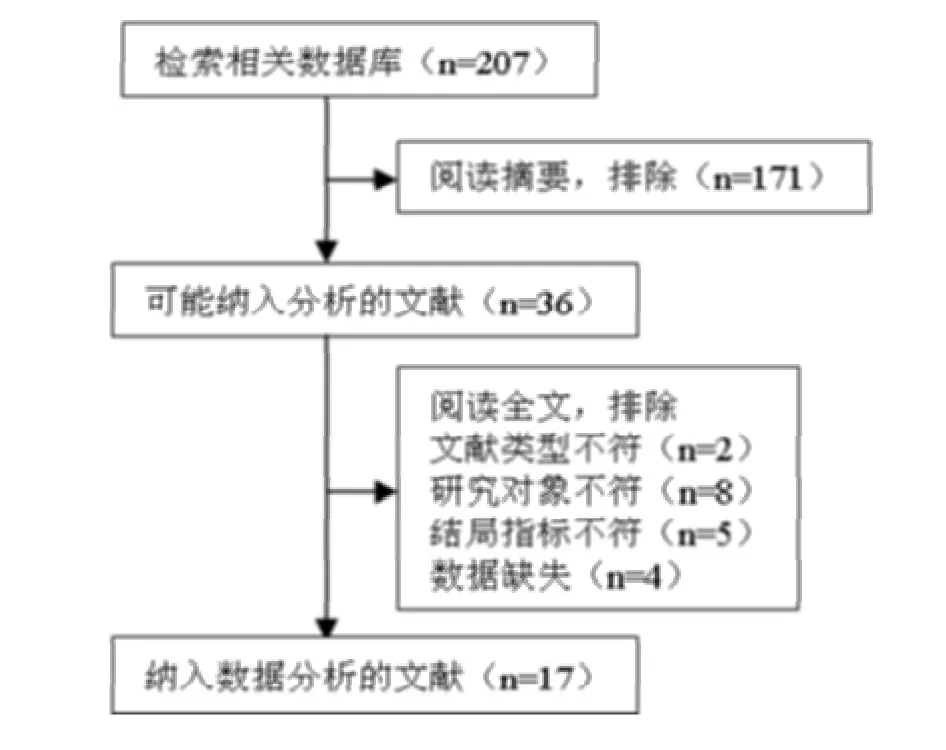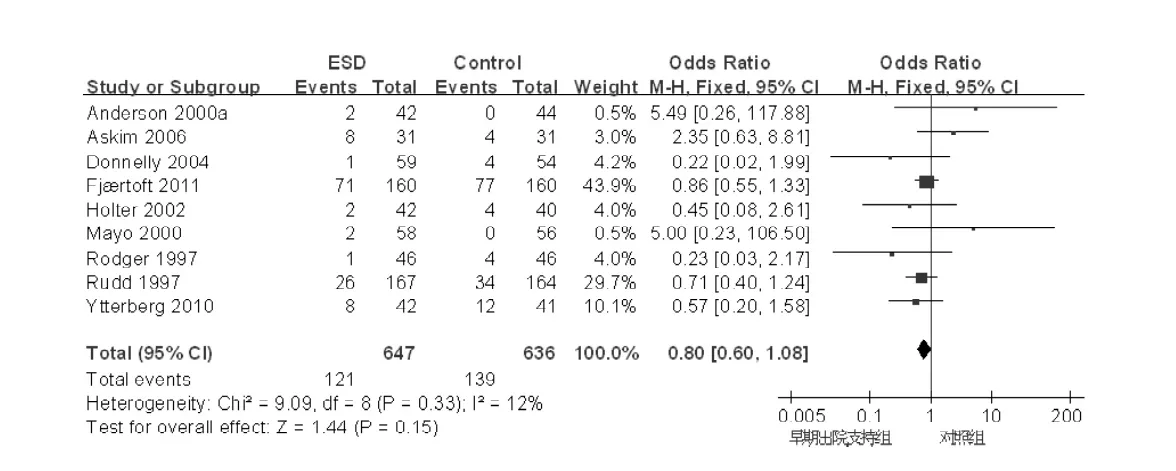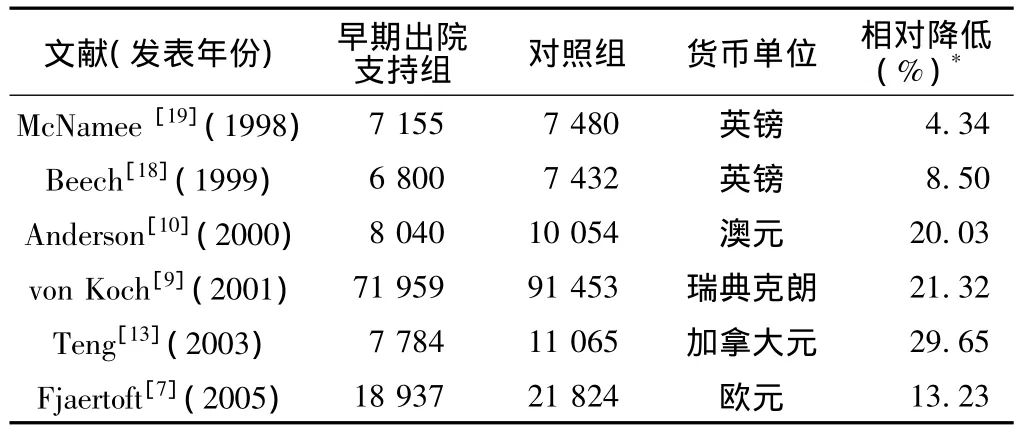早期出院支持策略对脑卒中患者的干预效果的系统评价
耿劲松,蒋 葵,陈亚兰,顾锦贤,倪衡建,董建成
早期出院支持策略对脑卒中患者的干预效果的系统评价
耿劲松,蒋 葵,陈亚兰,顾锦贤,倪衡建,董建成
目的 客观评价早期出院支持策略对脑卒中患者的干预效果。方法 检索Pubmed、Cochrane临床对照试验中心注册数据库、EMBase、Web of Science、中国学术期刊全文数据库、重庆维普中文科技期刊数据库、万方数据知识服务平台。评价证据质量,提取资料并进行数据分析。结果 共纳入17篇研究论文,由多学科医疗团队对轻、中度脑卒中患者提供早期出院支持策略。脑卒中早期出院支持组首次住院时间〔MD=9.98,95%CI(7.55,12.42),P<0.00001〕和总住院时间显著缩短 〔MD=11.64,95%CI(7.38,15.90),P <0.00001〕,人均医疗费支出相对于对照组降低4.34% ~29.65%。两组患者的病死率和照顾者压力差异无统计学意义 (P>0.05)。结论 多学科早期干预支持方案在脑卒中卫生服务提供过程中发挥积极作用,是一种可行的治疗模式。
早期出院支持;脑卒中;系统评价
脑卒中 (stroke)发病急,严重者表现为偏瘫、失语、昏迷甚至死亡,致残率高。第三次国民死因调查结果表明,脑卒中已经升为中国第一位死因。我国脑卒中医疗费用增速极快,近10年内增加19倍,预测到2020年国家的医疗保障负担将更加沉重[1]。WHO的卫生政策与体制研究联盟 (alliance of health policy and system research,AHPSR)一贯主张,卫生政策研究首先需要具有循证的方法和依据。本研究基于循证卫生决策的理念和方法,评价并整合早期出院支持策略对脑卒中患者干预效果的研究证据,以期为制定高效可行的脑卒中干预适宜技术提供决策支持。
1 资料与方法
1.1 文献检索 检索Pubmed、Cochrane临床对照试验中心注册数据库、EMBase、Web of Science、中国学术期刊全文数据库、重庆维普中文科技期刊数据库、万方数据知识服务平台。英文检索词:stroke、early discharge、early support;中文检索词:脑卒中、早期出院、早期支持。疾病名称与干预措施之间用AND连接。检索途径为摘要。检索年限从建库起至2011年7月。为提高查全率,追查纳入文献的参考文献。
1.2 纳入与排除标准 纳入标准:(1)随机对照试验;(2)研究对象为接受住院治疗的脑卒中患者;(3)试验组接受早期出院支持策略,对照组接受常规治疗。排除标准:(1)未评价本研究测量指标的文献;(2)数据缺失无法纳入统计分析的文献;(3)重复发表的文献。
1.3 测量指标 脑卒中患者的病死率、家庭照顾者的压力、经济学负担 (住院时间和人均医疗费支出)。
1.4 文献筛选 两名研究者根据纳入与排除标准独立筛选并交叉核对文献。首先阅读文题和摘要,排除明显不符合纳入标准的文献,对可能符合的文献通过阅读全文进行二次筛选,如遇分歧经由第三方评价员商议解决。
1.5 资料提取 提取内容包括题名、作者信息、发表期刊、年代、实施场景、研究的方法学质量、研究对象、干预及对照措施和结局指标。若某项研究分为若干时间段发表,则提取结局指标最后一次测定的数据[2]。
1.6 质量评价 参照Cochrane系统评价员手册制定的证据评价方法[2],从随机、隐蔽分组和盲法3方面评价纳入研究的质量,每项评价结果均以“是”、“否”、“不清楚”标明。
1.7 统计学方法 数据分析采用 Review Manager 5.1软件。用I2评估异质性的大小,若I2<50%则无统计学异质性,选择固定效应模型;若I2≥50%,进行异质性分析和处理,若仍无法消除异质性的资料,选择随机效应模型[2]。定性资料以OR及其95%可信区间 (CI)估计合并效应量,定量资料以均数差 (mean difference,MD)及其95%CI估计合并效应量,以P<0.05为合并效应量有统计学意义。
2 结果
2.1 文献检索结果 共检索到文献207篇,两次筛选后纳入分析文献共17篇[3-19](见图1)。

图1 文献筛选流程Figure 1 Flow diagram of study selection
2.2 纳入研究特征 纳入研究发表年代为1997~2011年,发表论文多见于Stroke(7篇)和Clin Rehabil(3篇)。研究开展的国家是英国、加拿大、澳大利亚、挪威和瑞典,研究对象为轻、中度脑卒中患者。各项纳入研究的共同特点是多学科医疗团队对脑卒中患者提供早期出院支持策略,并密切开展社区或家庭随访。多学科医疗团队成员通常包括物理治疗师、作业治疗师、言语治疗师、内科医师、护士和卫生志愿者。
2.3 纳入研究质量评价 纳入研究发生选择性偏倚的可能性低,其中10项研究运用计算机生成随机分配序列、5项研究借助于查阅随机数字表生成随机分配序列、2项研究采用中心随机系统分配患者入组并隐藏随机分配序列,14项研究采用密封且不透光的信封隐藏随机分配方案,1项研究的随机分配方案由第三方独立控制。此外,1项研究明确指出未实施盲法,2项研究没有提及具体的施盲方法,其余14项研究发生结果测量偏倚的可能性低 (见图2)。
2.4 数据分析结果
2.4.1 病死率 早期出院支持组与对照组患者的病死率差异无统计学 意义 〔OR=0.80,95%CI(0.60,1.08),P=0.15〕(见图3)。
2.4.2 照顾者压力 早期出院支持组与对照相比照顾者压力未增加 〔MD=0.08,95%CI(-0.13,0.28),P=0.46〕(见图4)。
2.4.3 住院时间 早期出院支持组较对照组患者首次住院时间显 著 缩 短 〔MD=9.98,95%CI(7.55,12.42),P <0.00001〕(见图5)。早期出院支持组较对照组患者总住院时间显著 缩 短 〔MD=11.64,95%CI(7.38,15.90),P <0.00001〕(见图 6)。
2.4.4 人均医疗费支出 早期出院支持组患者人均医疗费支出相对于对照组降低4.34% ~29.65%(见表1)。

图2 纳入研究质量评价汇总Figure 2 Risk of bias graph:judgements about each risk of bias item presented as percentages across all included studies

图3 脑卒中早期出院支持组与对照组患者病死率对比Figure 3 Early supported discharge versus conventional care for fatality rate in stroke patients

图4 脑卒中早期出院支持组与对照组照顾者压力对比Figure 4 Early supported discharge versus conventional care for strain in stroke carers

图5 脑卒中早期出院支持组与对照组患者首次住院时间对比Figure 5 Early supported discharge versus conventional care for initial length of stay in stroke patients

图6 脑卒中早期出院支持组与对照组患者总住院时间对比Figure 6 Early supported discharge versus conventional care for total hospitalization in stroke patients

表1 脑卒中早期出院支持组与对照组患者人均医疗费支出对比Table 1 Early supported discharge versus conventional care for cost per stroke patient
3 讨论
循证卫生决策是按照循证的理念处理和解决有关卫生的问题,即慎重、准确和明智地应用现有最佳的研究证据,同时根据当地实际情况和民众服务需求,将三者有机结合,制定出切实可行的卫生政策[20]。实现卫生政策的科学决策,循证卫生决策是重要的方式之一。本文基于卫生决策系统评价的研究方法,通过确定、选择和整合脑卒中早期出院支持策略的研究证据,客观评价干预效果及经济学指标,避免了一次性调查结果的误导,减少各种偏倚和随机误差。
本文评价证据的选择性偏倚和测量偏倚发现,纳入的随机对照试验质量较高,结果真实可信。因研究人员均知晓研究对象的确切干预措施,此类研究中无法对研究人员实施盲法,故本文未评价实施偏倚。研究结果表明,多学科医疗团队提供脑卒中早期出院支持服务在保证治疗效果、不增加家庭照顾者压力的同时,能缩短患者的首次住院时间和总住院时间,并降低人均医疗费支出,是一种可行的治疗模式。随着我国慢性病发病年龄的提前和人口老龄化趋势的加速,脑卒中防治形势更加严峻。单纯高额费用的投入只能解决或挽救个体生命,并不能有效降低脑卒中的发病率和病死率[21]。如何合理利用有限的卫生保健资源,寻找一种高效益低成本的脑卒中治疗模式以满足医疗保障需要成为近年来关注的热点。目前,我国大部分脑卒中患者的康复阶段是在社区和家庭中度过。脑卒中的管理既需要专科医生也需要初级卫生保健者的参与,多学科早期干预支持模式在卫生服务提供过程中起到积极作用。医院康复和社区康复都是以患者为中心的医疗活动过程,医疗团队通过跨学科协同合作,为早期出院患者制定个性化的治疗和康复方案,定期进行社区随访和干预,既能为患者提供高质量的医疗保健服务,又能有效降低卫生费用,是实现卫生服务高效性和公平性的有效途径[22]。
脑卒中早期干预支持策略能促进医疗卫生资源的合理利用,具有广阔的应用前景。建议通过构建高效能多学科卫生服务团队,结合国情积极探索多种干预模式,采取有效措施降低患者的经济负担,提升脑卒中患者的医疗服务质量。
1 卫生部.慢性大病渐成我国严重经济社会问题之一 [EB/OL].(2011-07-29)[2011-09-06].http://www.moh.gov.cn/publicfiles/business/htmlfiles/mohbgt/s6717/201107/52521.htm.
2 The Cochrane Collaboration.Cochrane Handbook for Systematic Reviews of Interventions(5.1.0)[EB/OL].(2011-03-01)[2011-08-06].http://www.cochrane-handbook.org.
3 Fjærtoft H,Rohweder G,Indredavik B.Stroke unit care combined with early supported discharge improves 5-year outcome:a randomized controlled trial[J].Stroke,2011,42(6):1707-1711.
4 Ytterberg C,Thorsén AM,Liljedahl M,et al.Changes in perceived health between one and five years after stroke:a randomized controlled trial of early supported discharge with continued rehabilitation at home versus conventional rehabilitation [J].J Neurol Sci,2010,294(1-2):86-88
5 Askim T,Mørkved S,Indredavik B.Does an extended stroke unit service with early supported discharge have any effect on balance or walking speed?[J].J Rehabil Med,2006,38(6):368-374.
6 Askim T,Rohweder G,Lydersen S,et al.Evaluation of an extended stroke unit service with early supported discharge for patients living in a rural community.A randomized controlled trial [J].Clin Rehabil,2004,18(3):238-248.
7 Fjaertoft H,Indredavik B,Magnussen J,et al.Early supported discharge for stroke patients improves clinical outcome.Does it also reduce use of health services and costs?One-year follow-up of a randomized controlled trial[J].Cerebrovasc Dis,2005,19(6):376-383.
8 Fjaertoft H,Indredavik B,Johnsen R,et al.Acute stroke unit care combined with early supported discharge.Long-term effects on quality of life.A randomized controlled trial[J].Clin Rehabil,2004,18(5):580-586.
9 von Koch L,de Pedro-Cuesta J,Kostulas V,et al.Randomized controlled trial of rehabilitation at home after stroke:one-year followup of patient outcome,resource use and cost[J].Cerebrovasc Dis,2001,12(2):131-138.
10 Anderson C,Rubenach S,Mhurchu CN,et al.Home or hospital for stroke rehabilitation?Results of a randomized controlled trial:I:health outcomes at 6 months[J].Stroke,2000,31(5):1024-1031.
11 Anderson C,Mhurchu CN,Rubenach S,et al.Home or hospital for stroke Rehabilitation?Results of a randomized controlled trial:II:cost minimization analysis at 6 months [J].Stroke,2000,31(5):1032-1037.
12 Donnelly M,Power M,Russell M,et al.Randomized controlled trial of an early discharge rehabilitation service:the Belfast Community Stroke Trial[J].Stroke,2004,35(1):127-133.
13 Teng J,Mayo NE,Latimer E,et al.Costs and caregiver consequences of early supported discharge for stroke patients[J].Stroke,2003,34(2):528-536.
14 Bautz-Holter E,Sveen U,Rygh J,et al.Early supported discharge of patients with acute stroke:a randomized controlled trial[J].Disabil Rehabil,2002,24(7):348-355.
15 Mayo NE,Wood-Dauphinee S,Côté R,et al.There's no place like home:an evaluation of early supported discharge for stroke[J].Stroke,2000,31(5):1016-1023.
16 Rudd AG,Wolfe CD,Tilling K,et al.Randomised controlled trial to evaluate early discharge scheme for patients with stroke[J].BMJ,1997,315(7115):1039-1044.
17 Rodgers H,Soutter J,Kaiser W,et al.Early supported hospital discharge following acute stroke:pilot study results [J].Clin Rehabil,1997,11(4):280-287.
18 Beech R,Rudd AG,Tilling K,et al.Economic consequences of early inpatient discharge to community-based rehabilitation for stroke in an inner-London teaching hospital[J].Stroke,1999,30(4):729-735.
19 Mcnamee P,Christensen J,Soutter J,et al.Cost analysis of early supported hospital discharge for stroke[J].Age and Ageing,1998,27:345-351.
20 Behague D,Tawiah C,Rosato M,et al.Evidence-based policymaking:the implications of globally-applicable research for contextspecific problem-solving in developing countries[J].Soc Sci Med,2009,69(10):1539-1546.
21 Mendis S.Prevention and care of stroke in low-and middle-income countries;the need for a public health perspective[J].Int J Stroke,2010,5(2):86-91.
22 Langhorne P,Bernhardt J,Kwakkel G.Stroke rehabilitation [J].Lancet,2011,377(9778):1693-1702.
Efficacy of Early Supported Discharge Strategy on Stroke
GENG Jin-song,JIANG Kui,CHEN Ya-lan,et al.Medical School of Nantong University,Nantong 226001,China
ObjectiveTo evaluate the intervention efficacy of early supported discharge(ESD)strategy on stroke.Methods Pubmed,Cochrane Central Register of ControlLed Trials,EMBase,Web of Science,CNKI,VIP and Wanfang Data were searched.Quality of eligible evidence was assessed,Data were extracted and analyzed.Results17 researches were included in the analysis.Multidisciplinary team offered ESD strategy to mild and moderate stroke patients.It was found that both the initial hospitalization time〔MD=9.98,95%CI(7.55,12.42),P < 0.00001〕and total hospitalization time 〔MD=11.64,95%CI(7.38,15.90),P <0.00001〕were notably reduced under ESD strategy.Total medical expense per person for ESD group was reduced from 4.34%to 29.65%,compared with the control group.No statistical significance was found between ESD group and control group in mortality rate and carer strain(P >0.05).ConclusionMultidisciplinary ESD strategy may play an active role in the process of health service improvement and is a feasible treatment mode.
Early supported discharge;Stroke;Systematic review
R 743.3
A
1007-9572(2011)12-4022-03
南通市社会发展科技计划项目 (S10919:基于循证卫生决策的脑卒中社区综合防治模式研究);南通市重大科技创新专项项目 (XA2009001:南通市社区居民健康与医疗卫生信息化保障体系示范工程)
226001江苏省南通市,南通大学医学院
董建成,226001江苏省南通市,南通大学医学院;
E-mail:dongjc@ntu.edu.cn
2011-09-13;
2011-11-22)
(本文编辑:王俊懿)

